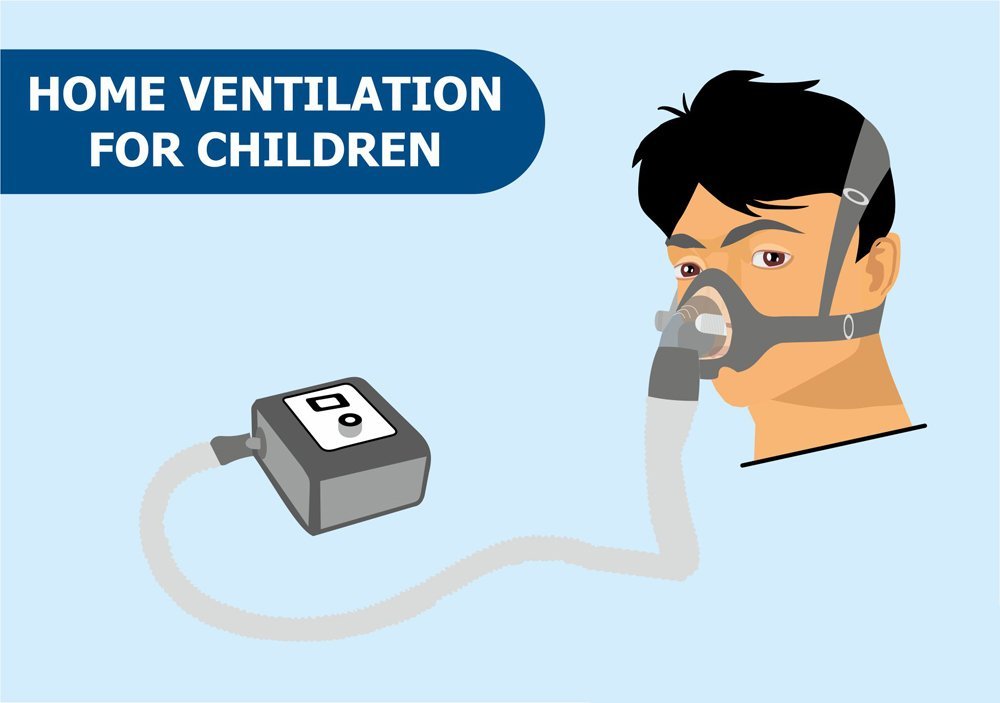
Pediatric Home Ventilation Program
Pediatric Home Ventilation Program, provides life-enhancing respiratory support within the comfort of a child’s home. This program is particularly vital for children with conditions such as Obstructive Sleep Apnea Syndrome (OSAS), Neuromuscular Disorders, and tracheostomy-dependent children. This section deals with an overview of home ventilation in children with a focus on which patients benefits from home ventilation and its key components.
Understanding Home Ventilation
Home ventilation refers to the use of mechanical respiratory support outside the hospital setting. This can include devices like CPAP (Continuous Positive Airway Pressure), BiPAP (Bilevel Positive Airway Pressure), or more advanced ventilators. These devices ensure that children with compromised respiratory function receive consistent and effective support tailored to their unique needs. Most children require respiratory support only at night when asleep and remain off it during the day.
Who Benefits from a Pediatric Home Ventilation Program?
- Obstructive Sleep Apnea Syndrome (OSAS): Children with OSAS often experience repeated airway obstruction during sleep. Some children require support during breathing with usually a CPAP machine (Continuous Positive Airway Pressure). Some children with OSAS require BiPAP (Bilevel Positive Airway Pressure) to prevent hypoxia, improve sleep quality, and enhance overall well-being.
- Neuromuscular Disorders: Disorders like muscular dystrophies, congenital myopathies or spinal muscular atrophy (SMA) can weaken respiratory muscles, making it difficult for children to breathe independently. This weakness is first during sleep. This weakness of the chest muscles can be diagnosed by doing a sleep study. Home ventilation provides crucial support to maintain adequate oxygen and carbon dioxide levels. This is called as “non-invasive ventilation” in form of BiPaP.
- Tracheostomy-Dependent Children: For children requiring a tracheostomy due to airway anomalies or prolonged respiratory support, home ventilation ensures continuous care in a familiar and less stressful environment.
Key Components of a Successful Pediatric Home Ventilation Program
- Comprehensive Assessment: Our multidisciplinary team evaluates the child’s respiratory needs, medical history, and family’s readiness to manage home-based care. A vital component of assessment is a good in-Lab sleep study which decides the need for ventilation.
- Custom Equipment and Setup: Devices are selected based on the child’s condition, and home environments are adapted to accommodate them safely. For children especially young babies carefully choosing the NIV mask is important.
- Family Training: Caregivers receive hands-on training to operate ventilators.
- 24/7 Support: Continuous access to medical experts ensures quick response to any complications or device malfunctions.
- Regular Monitoring: Periodic check-ups and remote monitoring help optimize therapy and make necessary adjustments.
The Pediatric Home Ventilation Program stands as a testament to the progress in pediatric pulmonology, offering hope and improved quality of life to children with complex respiratory needs. By fostering collaboration between healthcare professionals and families, this program ensures that children not only survive but thrive in the comfort of their homes.
Conclusion
Pediatric Home Ventilator Program at BLK MAX Hospital
The Pediatric Home Ventilator Program at BLK MAX Hospital is dedicated to supporting the care of children with diseases that require long term home mechanical ventilation. Our team works with the child and family, from diagnosing sleep related breathing problems, discussing the need and benefit of long term ventilation, choosing the most appropriate mask, helping the child to acclimatize to the system, choosing the best ventilator, troubleshooting equipment, managing infections etc. The aim is to achieve optimal growth and development, reduces hospital admissions to minimum and have the best possible quality of life.
Frequently Asked Questions (FAQs)
1. What conditions necessitate Non Invasive ventilation for children?
Non invasive ventilation is commonly prescribed for conditions like Obstructive Sleep Apnea Syndrome, Neuromuscular Disorders, chronic lung disease, and for tracheostomy-dependent children requiring respiratory support.
2. How is a child’s suitability for home ventilation determined?
A multidisciplinary team assesses the child’s respiratory needs, underlying conditions, and the family’s capability to manage care at home.
3. What training do caregivers receive?
Caregivers are trained to operate ventilators, troubleshoot issues, manage emergencies, and maintain hygiene for devices like tracheostomy tubes.
4. How often should children on home ventilation be monitored?
Regular monitoring schedules are tailored to each child, typically involving monthly check-ups and periodic remote assessments. Sleep studies are done every 6 months to 1 year to assess the adequacy of home ventilation and adjust the settings.
5. Can children on home ventilation attend school?
Yes, many children on home ventilation attend school since most of them are on the support only at night.



